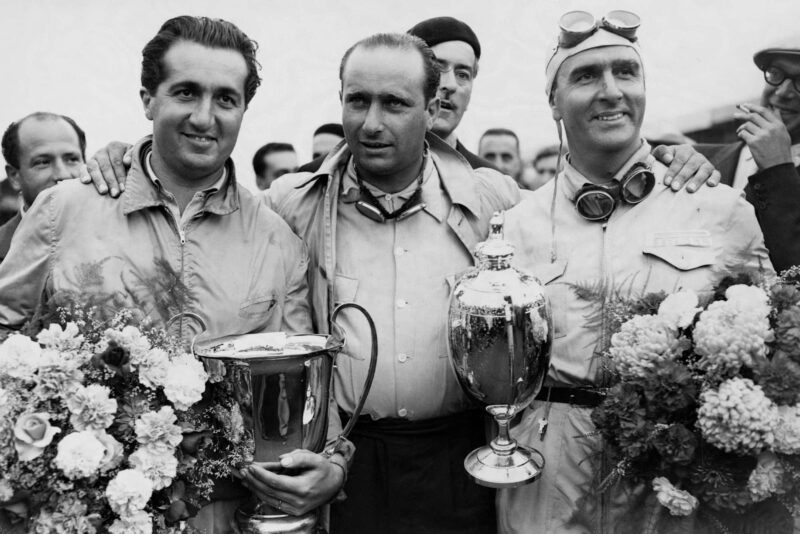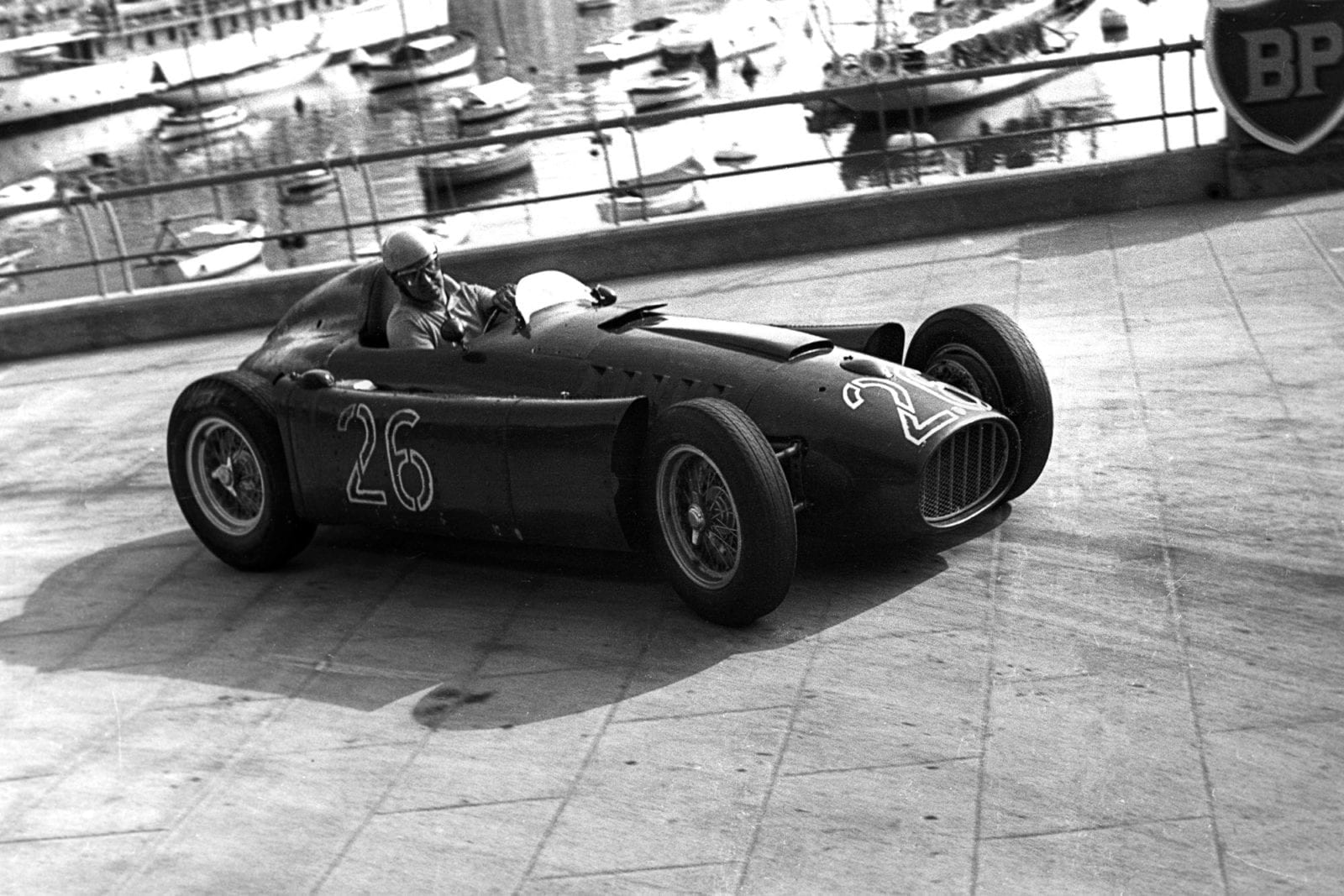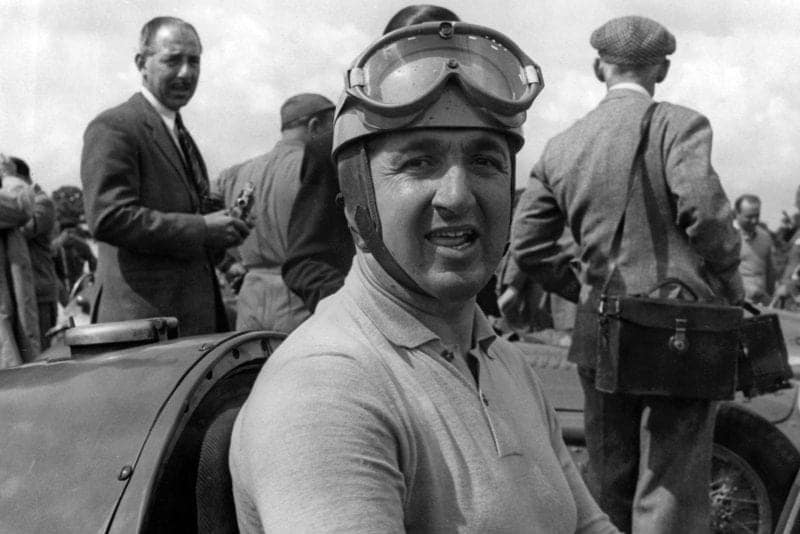This was June 22, and a year later – on June 23 1953 – Ascari won in Belgium again. In the course of those twelve months no one but he won a World Championship Grand Prix, and his record of nine consecutive victories will surely stand for ever: no one else has ever won more than seven. If the Ferrari 500 was indisputably the best car, so it was equally beyond doubt that Ascari was on his own.
By now Ascari had become a national hero, rivalled only by Fausto Coppi, the first man to win the Tour de France and the Giro d’Italia in the same year. The two gods of Italian sport became friends, and were similar in the way they worked. “Once Coppi broke away from the peloton,” wrote the French journalist Pierre Chany, “the peloton never saw him again…”
Ascari would take pole position as a matter of course, and be away down the road from the fall of the lag, whereupon ‘the peloton never saw him again’. Smooth, consistent, paralysingly fast, he won his races as Jim Clark would do a decade later.
By the end of 1953, though, Ascari had come to feel that he wasn’t being paid enough, a resentment only increased after learning from Coppi that top Italian cyclists were paid greatly more than racing drivers.
Alberto lived in a pleasant apartment on the Corso Sempione in Milan, and there was a modest villa in the country, but drivers were hardly in the business to get rich. “Knowing what they earn today,” Villoresi commented in the ’80s, “I would be embarrassed to say how little we were paid in those times…” In 1997, indeed, at the age of 88, Villoresi died in penury.
In Ascari’s mind always was the security of his family. While he adored his kids, he was a little stern with them, and Enzo Ferrari once took him to task over it. Alberto replied that he gave them everything he could to make them happy, but he didn’t want them to love him too much: that way they would suffer less if one day he didn’t come home.
Close as they always were – Ferrari said he thought of Ascari as a son – their association ceased at the end of 1953. Through that year Enzo had been muttering about pulling out of racing, citing the lack of financial support from a country to which his cars had brought so much glory. When Ascari and Villoresi – always the double act – went to see him in December, he refused still to confirm his plans, but at the same time was insistent that Alberto should sign a new contract immediately, rather than wait for the expiry of the current one, on April 30 1954. Ascari’s response was that if Ferrari would wait until then, he would probably re-sign, but if the decision had to be taken now, then it had to be no.
So it was that he and Villoresi sorrowfully took their leave, and the very next day travelled to Turin for a meeting with Gianni Lancia. Soon the news was confirmed that Lancia had embarked on the building of a Grand Prix car, designed by Vittorio Jano: Ascari and Villoresi would be the drivers, together with Alberto’s protégé Eugenio Castellotti.
A long time passed, though, before the car was race-ready. Ascari first drove the D50 in February, but it did not race until October, and in the meantime there was the absurdity of the reigning World Champion having little to do. At Reims, where Mercedes returned, and Silverstone, he drove a Maserati 250F, but each time the car let him down.
“Ascari was my man, my life just revolved around him” Mario Andretti
The high point of the year was the Mille Miglia, which Alberto won. Sports car racing was never much to his taste, and this event in particular he disliked, resolving not to take part again after an accident in the 1951 race, in which a spectator was killed. Italian law being the curious way it is, Ascari was charged with manslaughter, and it took three years for him to be formally exonerated. Although the Mille Miglia was excluded from his Lancia contract, he relented when Villoresi was hurt on a practice run, and agreed to take his place.
Delay followed delay with the D50, and hopes that it might make its debut at Monza came and went. It was unthinkable that the country’s greatest star should be absent from the Italian Grand Prix, and a factory Ferrari was made available: Ascari was instantly on it, fighting with Fangio’s Mercedes for the lead until his engine failed.
In the crowd that day were 14-year-old twins, Mario and Aldo Andretti, soon to leave for a new life in Nazareth, Pennsylvania.

Ascari (left) with Fangio (centre) and Farina after the 1952 British Grand Prix at Silverstone
Getty Images
“Ascari was my man,” says Mario. “My life just revolved around him. I used to read about him in Auto Italiana, and when I finally got to see him at Monza it was one of the best days of my life – when he died, just days before we left for the States, it was one of the worst. I never met the man, but he had a greater influence on my life than anyone else.”
The Lancia D50 made its debut in the Spanish Grand Prix at Pedralbes, and if the car was quick, it was also wayward, requiring Alberto temporarily to shed his silky style. He did,
however, take pole position – a second faster than Fangio – and led until his clutch failed.
Thus, if Ascari finished the year with not a championship point to his name, he looked to 1955 with optimism, confident of a car capable of fighting with Mercedes. In Argentina, the first round of the championship, he spun off on oil while leading, but then won non-championship races at Turin and Naples. In Monaco he started from the front row, sandwiched between Fangio and Moss.
In this race, extraordinarily, both the Mercedes failed, and when Moss blew up on lap 81, Ascari briefly – very briefly – led. At the chicane he found oil from Stirling’s car, and that, combined with the snatching brakes which always plagued the D50, was enough to put him through the flimsy barriers and out into the harbour.
Maurice Trintignant, who won the race, visited Ascari in hospital the next morning, and wrote about it in his memoirs. “Alberto was sitting up in bed, sucking oranges, and he was in great form – if it hadn’t been for the little bandage on his nose you’d never have known he’d had such a narrow escape.
“He said he knew he couldn’t catch Moss, and his pit had told him I was catching him. ‘To stop you,’ he said, ‘I had to take risks. At the chicane I slid on oil, and found myself heading for the sea. I went into the water in the car, but I managed to get out just as we were going down – it was a hell of a dive, and I hit the bottom. I was a bit stunned, but the cold of the water woke me up, and when I got to the surface a frogman was there to help me…’”
For another reason, too, the visit to Ascari made an impression on Trintignant. Alberto’s nickname was ‘Ciccio’ – ‘Chubby’ – and it’s undeniable that he liked his food, and was never exactly sylph-like, but then neither was Fangio, to say nothing of Gonzales, and none ever seemed to have stamina problems in races way longer than they are today.
“As it was hot,” Trintignant related, “Alberto was not wearing his pyjama top – and I realised we were wrong when we called him ‘chubby’. He had a wrestler’s powerful body, heavily muscled shoulders and a bull neck, strong biceps and forearms – exactly the right build for a rugby front row forward.”
Fangio always considered Ascari and Moss his greatest rivals: “Alberto was fast – terribly fast. He was a driver of supreme skill, and his only weakness was that he was so superstitious…”
He was indeed. Tales of his dread of black cats – he encountered one on the day of his first bad accident – are well documented, and he also had the more traditional misgiving about number 13 and its multiples: his father had been killed on the 26th of July.
As well as that, Ascari was obsessive about his racing equipment, and could not bear, as Villoresi noted, to have anyone else touch it. In particular, he had a thing about his pale blue helmet – always peakless – which he looked upon as his St Christopher. It is the more unfathomable, therefore, that on May 26 he should have chosen to set his phobias aside.
That morning at Monza Castellotti was testing a new, yet unpainted, Ferrari 750S, which became known as the 750 Monza. Ascari had been due to share the car with him in the Supercortemaggiore race on Sunday, but Alberto had apparently decided to give it a miss.
Why, then, did he take to the track? He had gone to Monza simply to watch Castellotti test, and was wearing his always immaculate suit and tie, clearly with no intention of driving; then, apparently on a whim, he decided that it would be a good idea to get back in the saddle.
Thus he took off his jacket, tucked his tie into his shirt, put on Castellotti’s white helmet, climbed aboard, and never came back. On his third lap, going harder now, he crashed at the Curva Vialone, a corner which should never have troubled one such as he.
Vialone – now renamed Ascari – had no chicane before it in those days, and was a flat-out left-hander. In the middle of the corner lurid tyre marks indicated that the Ferrari had got sideways, then turned sharp left and begun to somersault, in the course of which Ascari was crushed before being thrown out.
There had been no other car out there, and, hearing the sudden cut of the engine and the sounds of destruction, Castellotti, Villoresi and others rushed to Vialone, where they found Ascari barely alive, beyond saving.
Two days later the funeral took place, at the church of San Carlo al Corso in Milan, and as the cortege made its way there, the city was stilled, thousands lining the streets to pay final homage to an idol lost.
The cause was never definitively established. There were fanciful notions that maybe his tie had blown in his face, and there were those who suggested that Ascari had swerved to avoid someone crossing the track.
Hawthorn’s theory made more sense, a racer’s explanation: “The tyres we wanted to use for these cars were 6.50-16, but they were not available at the time in the particular make we were using, and so 7.00-16 covers had been fitted. I had driven the car with these tyres on it, and found it very nasty indeed at the Vialone Curve, where there were a lot of ripples in the road surface. I concluded that the rims were too narrow for the tyres, and had them taken off my car. Where Ascari crashed there were tyre marks, followed by marks of the wheel rims digging into the road, and it seemed to me that as he hit the ripples, the car started to slide, the tyres rolled under and the rims gouged into the road, causing it to somersault.”
Later in 1955, in a similar car, Paul Frère had an enormous accident in Sweden, and was lucky to escape with a broken leg.
“As many drivers discovered to their cost,” he wrote, “the Ferrari 750 Monza does not forgive a mistake. I came into a bend a fraction too fast, and the tail of the car swung round so quickly that I couldn’t hold it – the car had taken complete charge of the situation.”
Ascari’s death brought an end to Lancia’s racing activities. Although a distraught Castellotti was allowed to race a D50 at Spa, bravely putting the car on pole position, and although Hawthorn was signed to lead the team, Gianni Lancia then made a decision to pull out, and in July the cars were handed over to Scuderia Ferrari.
Ferrari, now receiving some financial help from Fiat, raced the modified cars as ‘Lancia-Ferraris’, and Fangio’s sole season with the team resulted in his fourth World Championship. His third had come the year before. “I felt,” Juan Manuel said, “that my title in 1955 lost some of its value because Ascari was not there to fight me for it. I lost my greatest opponent, and also a loyal and generous friend.”
Fifty-seven years on Alberto Ascari remains the last great Italian driver. “He had,” said Villoresi, “the clarity and presence of mind of Varzi, together with the fighting spirit of Nuvolari. There was no one better…”



